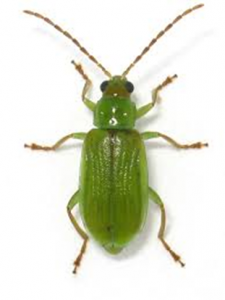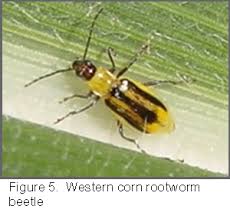Dave Wilson, Research Agronomist
In 2014, we had a customer in Belleville, Pennsylvania report rootworm problems with a Bt corn hybrid, possibly suggesting rootworm resistance to the trait. This began an investigation into a trend toward resistance that more customers are struggling with.
We notified Dr. John Tooker, Associate Professor of Entomology at Penn State University. Dr. Tooker looked into this matter, collected other information and reported back to us about this situation.
While the situation is complicated, the population of western corn rootworms from Belleville appears to have developed partial resistance to the Bt traits that were present in those fields. In lab feeding tests on Bt corn, rootworms from the Belleville population survived about three times better than rootworms known to be completely susceptible to the Bt toxin. However the rootworms from Belleville also only survived about half as well as a population of rootworms known to be resistant to the Bt trait. This means that the Belleville population was somewhat, but not fully, resistant to the Bt traits.
To avoid populations of rootworm that may develop resistance to Bt traits, Dr. Tooker encourages rotating corn with soybeans or alfalfa, and not growing more than two years of continuous corn. The problematic fields in Belleville were in corn for just three years. It seems that nearly any population of rootworms exposed to continuous corn could develop resistance; it is unlikely that the Belleville incident was an isolated event.
Tim Fritz additionally recommends, “If growers do not use proper crop rotation, they should use either a corn hybrid with a two mode of action trait brand such as EZ Refuge (MCT5375) or Duracade (MCT4058), or use a soil insecticide.”
Background
Rootworm resistance to the transgenic Cry Protein (Cry3Bb1) is the main component of Bt resistance and has been observed in several Midwestern states, including Illinois, Iowa, Minnesota, Nebraska, and South Dakota.
If we grow corn after corn with the same trait, resistance to the Bt trait builds up over time.
Farms that grow continuous corn year after year, or have short rotations with corn, (without changing-up modes of control) are providing the right conditions for rootworm to develop resistance. This issue provides a good reminder that relying on agronomic fundamentals (such as crop rotation and rotating insecticide chemistry by using a diversity of rootworm control insecticides) may be just as effective, or more so, than traits.
Long term (greater than 3 years) continuous corn can greatly increase rootworm and other pest problems. Corn rootworm damage is seldom a problem in field corn when the corn is rotated to a different crop within three years after the field is first planted to corn.
The two main types of rootworm to be aware of are Northern and Western Rootworm. Western rootworm usually hatches earlier, and has shown resistance to the Bt trait in the Midwest.
Management context
Seed treatments do not appear that effective against rootworms, and can be influenced by basic agronomic practices. Most insecticide seed treatments are effective for only 2-3 weeks, so early-planted corn whose emergence and early growth may be slowed by cool weather may be susceptible to rootworms.
In Southeastern Pennsylvania rootworms hatch in late May to early June, at which point the seed treatment is unlikely to provide protection for early-planted corn.
In Central Pennsylvania eggs typically begin hatching between June 1 and June 15. Hatching may occur 7 to 10 days later in northern cooler parts of the Pennsylvania or at higher elevations. The total hatching period is typically three to four weeks long.
To complicate things further, hatching is related to soil temperature. A cooler, wetter year like 2014 probably delayed hatching, further reducing effectiveness of seed insecticide treatments because the effectiveness of the seed treatment dwindles with time. And cool soil temperatures will slow seed germination, meaning the seed is in the soil longer before emerging. This makes the seed and its early root development more vulnerable to rootworms once they hatch and begin feeding. Also, excessive amounts of rain in spring can flush seed treatments from the seed zone.
Be aware that seed treatments containing Poncho or Cruiser 250 are not labeled to control rootworm; only 1250 doses of the two insecticides claim to have some effectiveness against them. Now I have seen that even the C-1250 is also not working as effectively at some locations, and it seems the rootworms are building up a tolerance for it.
Other management questions to ask if there is rootworm damage –
- Were in-row insecticides used?
- Was any scouting done to look for rootworm presence or abundance?
- Was corn planted previously on adjacent fields? Adult corn rootworm beetles can be very mobile
If the answer is no, these considerations can be used as preventative measures in subsequent years.
Larvae stages
Western and Northern Corn Rootworm have only one generation per year. Eggs are deposited in the soil (typically around the base of the corn plants) during mid-summer through autumn, they overwinter, and hatch in late May through early June the following year. Eggs hatch over the course of 3-4 weeks. Then the larvae pass through the instar stages. Most feeding is done in the later instar stages, then pupating and egg-laying takes place again from mid-July to mid-August.
Adult stages
Adult Northern Corn rootworm beetle
Adult Western Corn rootworm beetle
Picture from: bugguide.net
Adult beetles feed on pollen, silk and leaves, and can move among fields more readily. They can also feed on soybean flower pollen or late-flowering weed pollen.
Control tactics
Control late weeds in soybeans to help prevent the adults from laying eggs in fields that will be rotated to corn.
However, larvae can’t survive on the roots of broadleaf plants like soybeans or alfalfa, so those in fields that are rotated to legume or other broadleaf crops for another year aren’t likely to survive.
Rotating out of corn for more than one year can greatly reduce rootworm problems and this is still my PRIMARY recommendation.
Scout for rootworm damage as well as adult feeding activities in fields that are planned for corn the following year. Scout for emerged beetles in late May to early July, and keep records of any insect pressure.
Corn plants that lodge or fall over easily are a key indicator of possible larval feeding of roots. Dig and check the roots of fallen plants for signs of chewing.
Watch for adult beetles feeding on pollen, silk and ear tips.
In problem areas or corn after corn areas, you can also –
- Look at alternatives or additions to the Bt trait (Corn hybrids with multiple Bt traits which give multiple modes of action)
- Use in-row insecticides at planting.
- Rotate insecticide chemistry
- For early planted fields (Before May 1) recommendations are to apply the insecticide with cultivation or at side-dressing time if side-dressing is done (instead of at planting time). This is done to align timing of the insecticide application and effective window with the hatching of the eggs and larvae presence for better control.
In the recent past many farms had become very reliant on Bt corn traits to control corn rootworm, and this was effective for some time. As a result, many new planters that came out during that period of time weren’t ordered with insecticide boxes and the insecticide boxes on older planters weren’t utilized much. Over time, more occurrences of corn rootworm adaptation have occurred and currently we will see many new planters coming out again with insecticide boxes included. We have come full circle.
One lesson to be learned from any pest problem is that most pests can adapt to most management practices that are used year after year – even traits. Mix it up with a lengthy rotation and use as much diversity as possible. This applies to crops, varieties, chemicals, and traits, and even tillage/no-till practices.
Speak to an expert at King’s AgriSeeds now at 1-717-687-6224 or email us at [email protected].


